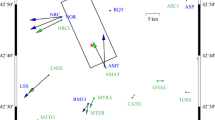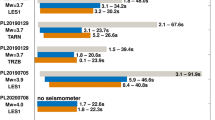Abstract
High-rate GPS measurements of earthquake-induced strong crustal movements reveal important information on large amplitude displacements, which cannot be obtained by other seismic monitoring equipment. However, obtaining accurate measurements of these strong movements can be challenging, because large magnitude earthquakes (M > 7) affect a wide area surrounding the epicenter. As a result, the GPS recorded movements are calculated with respect to distant sites (relative positioning), or with satellite parameters estimated from distant sites (precise point positioning). In order to improve the accuracy of the strong motion GPS measurements, we developed a new method, based on a spatial filtering technique. The method calculates the displacement of a high-rate monitoring network with respect to a moving near field site and uses a stacking technique to remove the movements of the reference site from all the time series. We applied the new method to the analysis of 5 Hz data acquired by the Nicoya Peninsula network, which recorded strong crustal movements induced by the 2012, M = 7.6 Costa Rica earthquake. The results were successfully tested with respect to 1 Hz time series calculated with a far field reference site. The spatial filtering method also removes other systematic common noise from the time series, possibly due to atmospheric delay or orbital errors and, hence, produces more accurate solutions that those based on far fields sites, or on near field site experiencing earthquake-induced action.




Similar content being viewed by others
References
Adalgeirsottir G, Smith AM, Murray T, King MA, Makinson K, Nicholls KM, Behar AE (2008) Tidal influence on Rutford Ice stream, West Antarctica: observations of surface flow and basal processes from closely spaced GPS and passive seismic stations. J Glaciol 54(187):715–724
Bock Y, Melgar D, Crowell BW (2011) Real-time strong-motion broadband displacements from collocated GPS and accelerometers. Bull Seismol Soc Am 101:2904–2925. doi:10.1785/0120110007
Crowell BW, Bock Y, Melgar D (2012) Real-time inversion of GPS data for finite fault modeling and rapid hazard assessment. Geophys Res Lett 39:L09305. doi:10.1029/2012GL051318
Herring TA (2009b) TRACK GPS kinematic positioning program, version 1.21. Massachusetts Institute of Technology, Cambridge
Herring TA (2009c) Example of the usage of TRACK. Massachusetts Institute of Technology, Cambridge. http://geoweb.mit.edu/_tah/track_example/
Jiang Y, Wdowinski S, Dixon TH, Hackl M, Protti M, Gonzalez V (2012) Slow slip events in Costa Rica detected by continuous GPS observations, 2002–2011. Geochem Geophys Geosyst 13:Q04006. doi:10.1029/2012GC004058
Larson K, Bodin P, Gomsberg J (2003) Using 1 Hz GPS data to measure deformations caused by the Denali fault earthquake. Science 300:1421–1424
Outerbridge KC, Dixon TH, Schwartz SY, Walter JI, Protti M, Gonzalez V, Biggs J, Thorwart M, Rabbel W (2010) A tremor and slip event on the Cocos-Caribbean subduction zone as measured by a GPS and seismic network on the Nicoya Peninsula, Costa Rica. J Geophys Res 115(B10):B10408. doi:10.1029/2009jb006845
Schone T, Pandoc W, Mudita I, Roemer S, Illigner J, Zech C, Galas R (2011) GPS water level measurements for Indonesia’s Tsunami Early Warning System. Nat Hazards Earth Syst Sci 741–749. doi:10.5194/nhess-11-741-2011
Wang G, Boore DM, Tang G, Zhou X (2007) Comparisons of ground motions from collocated, closely spaced one-sample-per-second Global Positioning System, accelerograph recordings of the 2003 M 6.5 San Simeon, California, earthquake in the Parkfield Region. Bull Seismol Soc Am 97(1B):76–90
Wdowinski S, Bock Y, Zhang J et al (1997) Southern California permanent GPS geodetic array: spatial filtering of daily positions for estimating coseismic and postseismic displacements induced by the 1992 Landers earthquake. J Geophys Res 102:18057–18070
Yin HT, Zhang PZ, Gan WJ, Wang M, Liao H, Li XJ, Li J, Xiao GR (2010) Near-field surface movement during the Wenchuan Ms8.0 earthquake measured by high-rate GPS. Chin Sci Bull 55. doi:10.1007/s11434-010-4026-2
Acknowledgments
We acknowledge UNAVCO as the source of the high-rate GPS data. We thank Professor Thomas Herring for his patient guidance in operating his kinematic GPS data processing program “TRACK” module of GAMIT/GLOBK. This work was supported by National Technology Support Project (2012BAK19B04), the National Natural Science Foundation of China (41104023), China Scholarship Council.
Author information
Authors and Affiliations
Corresponding author
Rights and permissions
About this article
Cite this article
Yin, H., Wdowinski, S. Improved detection of earthquake-induced ground motion with spatial filter: case study of the 2012 M = 7.6 Costa Rica earthquake. GPS Solut 18, 563–570 (2014). https://doi.org/10.1007/s10291-013-0353-5
Received:
Accepted:
Published:
Issue Date:
DOI: https://doi.org/10.1007/s10291-013-0353-5




